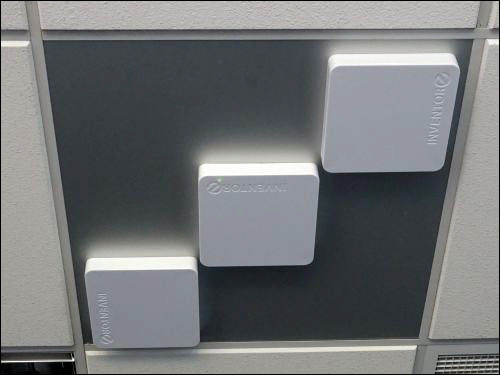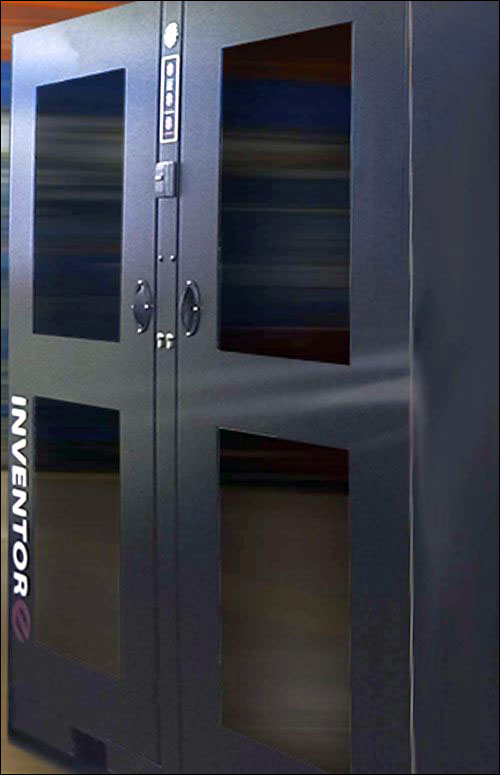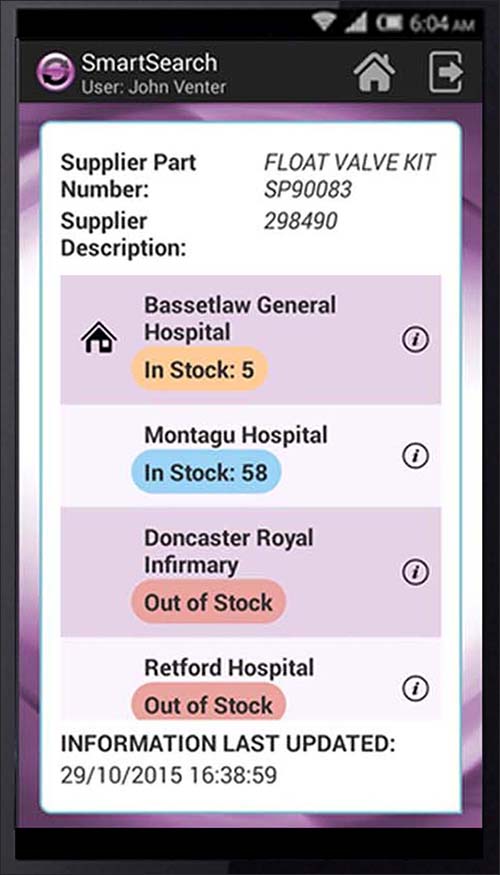Sometimes, a multitude of technologies is the best way to track assets or individuals within facilities or in the field. RFID tags or Bluetooth beacons alone, for instance, might not enable a company to easily monitor the locations of assets as they are taken from a factory, warehouse or office and loaded into a van, as well as identify where they were removed from that vehicle and why. But beacons, together with Electronic Product Code (EPC) and Near Field Communication (NFC) passive RFID tags, can be deployed to enable a wide variety of data-collection methods to determine where an item or person is going within a building, across a parking lot and inside a vehicle. That data can then be made available via an app or hosted software.
U.K. company Inventor-e has built an assortment of flexible solutions combining all three technologies. A variety of users, including managers of hospital supplies, facilities-management companies and shipyard operators, have deployed Inventor-e’s SmartStores solution to manage items that their employees use. In addition, several businesses have begun trials of the company’s SmartVan stock-management solution across their vehicle fleets.

Inventor-e first opened for business in 2001. The firm launched an industrial vending solution known as iVend, using electronic kanban technology based on weight sensor data. Current customers for that vending solution include aerospace and global consumer goods manufacturers.
More recently, the company added RFID technology to its offerings, says Dean Henry, Inventor-e’s CEO, in order to provide a more automated method of collecting data about items such as health-care supplies and expensive assets, including oscilloscopes and medical instruments. The solutions using RFID have consisted of Inventor-e’s own ultrahigh-frequency (UHF) RFID readers to track the movements of tools, consumables and assets as they are moved into or out of key areas, such as cabinets or across a specific site. The company is now incorporating beacon and NFC readers into its receiver devices to provide further flexibility, by collecting BLE-based location data in some cases—such as the movements of tags at a distance—while using EPC UHF RFID in other cases requiring more specific location data (within a zone, for instance) or NFC for cases in which a user needs to identify a single tag at close range.
This summer, the company is releasing its Smartie tag to enable asset tracking within vans or emergency vehicles. The Smartie contains an NXP Semiconductors NFC RFID inlay and a Bluetooth Low Energy (BLE) beacon that supports both the iBeacon or Google Eddystone specifications. Inventor-e also employs passive EPC Gen 2 UHF RFID inlays made with Impinj chips.
To track assets and tools loaded into a van, a user attaches a Smartie tag to each item. The Smartie can also be worn as a badge by drivers or other personnel. A driver can utilize his Android-based smartphone, running Inventor-e’s SmartStores app, to identify each tagged item via the smartphone’s NFC or BLE radio, and display an alert in the event of a problem, such as an expected item’s tag not being read within the van. The app also comes with a SmartSearch function enabling users to locate any assets or consumable items across the entire enterprise.
Inventor-e’s cloud-based software-as-a-service (SaaS) solution, known as Sourcerer, can then provide data to a company across a fleet of vans, identifying which vehicles are missing items, when those assets went missing and where a particular van was located when a specific item was no longer detected. This same platform integrates Inventor-e’s suite of vending, asset-management and supply-tracking solutions in one central location, thereby providing an enterprise view of assets, supplies and transactions.
For instance, if a driver wanted to document which items he places into or removes from the van, he would first sign into the smartphone app to identify himself and select from available actions. He could then use his smartphone’s NFC radio to read the NFC RFID inlay of each item’s Smartie tag, thereby creating a record of those actions, which would then be stored in the app. (Such an application leverages the Smartie tag’s NFC technology instead of its beacon, since NFC has a read range of only a few inches, thus enabling the user to identify only the items he is loading or removing.)

The driver could then use his phone’s Bluetooth radio to conduct a van-wide inventory count of all items onboard his vehicle, with the app issuing an alert if anything is discovered to be missing. The Smartie tag’s beacon has a read range of approximately 30 meters (98 feet). The software could match the NFC reads with the BLE reads and determine whether the missing item was deliberately removed, and by whom, during the time of the NFC read. The software could also document the reason that an item was removed, provided that the driver had taken the time to manually enter that information into the app. According to the company, the Smartie tag is expected to become commercially available later this summer.
In addition, the company developed a device called the iSite, which combines an EPC Gen 2 UHF RFID reader with a BLE radio. The device is powered via an Ethernet cable and can be installed in the ceiling of an office or other facility, inside a cabinet or within an emergency van. It can then begin collecting data in real time, based on UHF RFID tag reads, as well as any beacon transmissions. The iSite’s RFID reader typically has an 8-meter (26.2-foot) read range, while its Bluetooth radio can pick up the beacon transmissions of a Smartie tag located as far away as 30 meters (98 feet). The iSite is sized to replace a standard ceiling tile measuring 60 centimeters by 60 centimeters (23.6 inches by 23.6 inches). This product has been installed at several locations, Henry says, including a medical instruments manufacturer in Wales.
If multiple iSite devices are installed across a site, each device can be used to create a zone in the Inventor-e software to identify where a specific Smartie-tagged item is located, using the RFID reader to provide a higher level of location granularity, or using the BLE radio to establish a larger read zone. For instance, if Smartie-tagged assets are distributed throughout a facility, the UHF RFID reader in iSite devices can identify a particular object’s location within the building, while the BLE radio could continue to track the tagged item if an individual were to remove it, all the way out to a vehicle parked outside. If an iSite device were also installed within a van, the system could monitor an asset’s movement from inside a facility into that specific van, and then out of that vehicle, without a break in coverage.
The variety of technologies built into the iSite, Henry explains, “can all be talking to our software independently.” The software then links and compares the data to provide analytics, alerts and other useful information.
Inventor-e also offers its SwiftQ reader, which can be mounted on walls and linked to the Sourcerer software via a cable or Wi-Fi connection. The iSite functions similarly, but replaces a ceiling tile and incorporates three pairs of antennas to cover a wider area. The SwiftQ reader has a pair of integrated antennas, but can also take an external auxiliary antenna.
To date, the majority of Inventor-e’s customers are distributors that are using Inventor-e’s hardware and software to create solutions for their own customers in health care or other markets. Most are located in either the United Kingdom or Germany, Henry reports. These companies are using a variety of solutions based on NFC or EPC RFID so far.

For instance, Rexel UK, a distributor of electrical supplies, offers solutions for companies that want to track goods and personnel within vehicles. The company’s clients are seeking ways in which to manage the movements of goods and individuals in the vans, according to Stuart Axtmann, a Rexel UK national account manager, “to enable the clients’ mobile engineers to be a lot more productive and spend less time in their vans.” Rexel is using NFC technology as part of its solutions with Inventor-e’s SmartStores app. NFC RFID tags are attached to items stored in bins or on shelving units, and staff members use the NFC readers built into their Android mobile phones to scan the tags as they remove those assets from a vehicle. “We had considered bar-coding,” Axtmann recalls, “but found that NFC technology was cheaper to deploy, more resilient, easier to use and adaptable to incorporate new solutions as and when they become available.”
In addition, Henry says, Inventor-e is developing an access-controlled vending cabinet known as VendNFC, so that individuals can use their NFC-enabled Android smartphones to access equipment. A worker would simply present his phone to the cabinet’s NFC RFID reader, which would forward the data to the software in order to grant him access to the required tools or equipment. The VendNFC solution is anticipated to be available within about eight weeks, he notes.
Inventor-e continues to develop the Sourcerer platform as well. John Venter, the company’s CTO, decided to redesign the platform five years ago to provide scalability and the potential for extensions, as, Henry says, “the Windows-based platform we were using became too restrictive when we considered our future development plan.”
With the redevelopment, Henry adds, “the extensibility of the platform allows us to easily integrate new technologies and hardware, whilst allowing for simple integration to third-party ERP systems.” The continued overall strategy behind the technology, he says, is to provide real-time solutions to manage unmanned and manned storage facilities and distributed supplies, such as items stored in vans.

